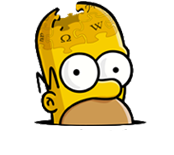
Difference between revisions of "Tales from the Public Domain/References"
Wikisimpsons - The Simpsons Wiki
Mythigator (talk | contribs) m (→Cultural references) |
m (→Hot Child in the City: removing unneded spaces, replaced: →) |
||
| Line 20: | Line 20: | ||
*The segment title comes from "{{w|Hot Child in the City}}", a song by {{w|Nicky Gilder}}, and is a reference to Joan's death by being burned at the stake. | *The segment title comes from "{{w|Hot Child in the City}}", a song by {{w|Nicky Gilder}}, and is a reference to Joan's death by being burned at the stake. | ||
*[[Marge]] quotes the {{w|Frère Jacques|Frère Jacques melody}} when she says "Morning bells are ringing! Morning bells are ringing!" | *[[Marge]] quotes the {{w|Frère Jacques|Frère Jacques melody}} when she says "Morning bells are ringing! Morning bells are ringing!" | ||
| − | *When Homer gets to the end of Joan's story, Marge {{w|Expurgation|Bowdlerizes}} the ending by saying that Joan was rescued by {{w|Lancelot|Sir Lancelot}} | + | *When Homer gets to the end of Joan's story, Marge {{w|Expurgation|Bowdlerizes}} the ending by saying that Joan was rescued by {{w|Lancelot|Sir Lancelot}} and they got married and lived on a spaceship (instead of Joan being burned at the stake). Marge then conceals her deception by ripping the story's last page from the book and eating it, remarking that it's easier to chew than the ''{{w|Bambi}}'' video. Marge's remark is a reference to the scene where Bambi's mother is killed by hunters, which was considered controversial and was criticized for its having a traumatic effect on children who saw the movie.<ref>[http://www.emanuellevy.com/review/bambi-2/ Emanuel Levy's review of ''Bambi'']</ref> |
*The flags of England and France shown at the beginning of the episode are the modern ones, they were not those in use in 1400. | *The flags of England and France shown at the beginning of the episode are the modern ones, they were not those in use in 1400. | ||
*The English castle has the features of {{w|Highclere Castle}}. | *The English castle has the features of {{w|Highclere Castle}}. | ||
Revision as of 20:39, August 3, 2021
|
|||||||||
|
|
|
Contents
Cultural references
D'oh, Brother Where Art Thou?
- The segment is a re-telling of the Odyssey, an epic poem by the Greek poet Homer, with Homer cast as Odysseus.
- When Lisa reads the title (Homer's Odyssey), Homer mistakes the story for an Odyssey minivan he once rented.
- The segment title is a pun on the movie O Brother, Where Art Thou?, which was also based on the Odyssey.
- When Odysseus' ship almost reaches Ithaca and Poseidon sends it back the way it came, he says, "Ain't I a stinker?" This is a direct reference to the classic Looney Tunes cartoon Duck Amuck (1953), in which Daffy Duck is tormented by an invisible animator, who turns out to be Bugs Bunny. At the end of the cartoon, Bugs grins at the audience and says, "Ain't I a stinker?"
- The song that the Sirens (Patty and Selma) sing to entice sailors to their island is sung to the tune of "Copacabana" by Barry Manilow.
- When Odysseus crosses the River Styx to go through Hades, the music playing is "Lady" by Styx.
- One of the zombies dancing on the banks of the Styx river is Pete Townshend (doing the windmill).
- Dionysus reminding Zeus that he used to "turn into a cow and pick up chicks" is a reference to the myth of Europa.
- The Ouzo, the drink that Discus Stu brings to Penelope, is a classic Greek alcoholic drink still used today, commonly served as an apéritif.
Hot Child in the City
- The segment is a re-telling of the story of Joan of Arc, with Lisa cast as Joan.
- Marge confuses Joan of Arc with American actress Joan Van Ark.
- The segment title comes from "Hot Child in the City", a song by Nicky Gilder, and is a reference to Joan's death by being burned at the stake.
- Marge quotes the Frère Jacques melody when she says "Morning bells are ringing! Morning bells are ringing!"
- When Homer gets to the end of Joan's story, Marge Bowdlerizes the ending by saying that Joan was rescued by Sir Lancelot and they got married and lived on a spaceship (instead of Joan being burned at the stake). Marge then conceals her deception by ripping the story's last page from the book and eating it, remarking that it's easier to chew than the Bambi video. Marge's remark is a reference to the scene where Bambi's mother is killed by hunters, which was considered controversial and was criticized for its having a traumatic effect on children who saw the movie.[1]
- The flags of England and France shown at the beginning of the episode are the modern ones, they were not those in use in 1400.
- The English castle has the features of Highclere Castle.
- The castle of the French has the features of the Château d'Ussé.
- The phrase that Joan says in her speech before attacking the British, "Their concept of individual rights could undermine the power of our beloved tyrants", is a reference to the fact that in England the Magna Carta had recently been approved, the first example of a king granting rights to his subjects.
Do the Bard, Man
- The segment is a re-telling of Hamlet by William Shakespeare, with Bart cast as Prince Hamlet.
- The segment title is a pun on "Do the Bartman" (one of Bart's catchphrases), and a reference to "The Bard" being a well-known nickname for Shakespeare.
- Bart finds the story to be boring, but Homer tells him it was later made into a great movie, called Ghostbusters. The family then dance to the Ghostbusters theme song.
- Bart says Steven Bochco is better than William Shakespeare as a writer.
- The banner with the phrase "Danes do it melancholy" is a reference to the melancholy character of Hamlet's character in the original tragedy.
Trivia
Opening Sequence
- The book Classics for Children, which Homer reads to Bart and Lisa, is a framing device for the episode. The stories that Homer reads become the episode's segments, where various Springfieldians are cast in the roles of the historical, mythological, or literary characters that appear in the stories.
D'oh Brother, Where Art Thou?
- Characters cast as Odysseus' crew include the following:
- Professor Frink wasn't with Odysseus' crew when they were turned into pigs by Circe. He was last seen when they went to the Island of the Sirens. The sight of the Sirens made Frink's glasses break and caused him to cry out loud, "Save me from the ladies!"
- Characters cast as Penelope's suitors include the following:
- Groundskeeper Willie
- Krusty the Clown
- Kent Brockman
- Principal Skinner
- Kirk Van Houten
- Disco Stu (as Discus Stu)
- Sideshow Mel
- Mr. Burns
- When Odysseus returns, he kills Krusty, Kirk, Willie, Burns and Mel.
Do the Bard, Man
- Every character in the segment (except Krusty) dies. Here's a list of how they all died:
- Hamlet (Bart) – Slipped on blood and died.
- Ghost of Hamlet's Father (Homer) – Killed when Claudius poured poison in his ear.
- Claudius (Moe) – Killed when Hamlet stabbed him.
- Polonius (Chief Wiggum) – Killed when Hamlet stabbed him who thought he was Claudius.
- Laertes (Ralph Wiggum) – Unintentionally stabbed himself when practicing his duel with Hamlet.
- Ophelia (Lisa) – Jumped out a window and landed in a moat where she drowned.
- Rosencarl and Guildenlenny (Carl and Lenny) – Died when they high-fived each other after being covered in poison.
- Gertrude (Marge) – The last person left alive, she dispatched herself with a mace to avoid all the cleaning up.
Goofs
Do the Bard, Man
- When King Hamlet's ghost visits Hamlet, he switches from semi-transparent to solid between scenes.
- When Lenny and Carl die, they are seen falling to the ground right next to each other, but when Marge is looking at all the dead bodies, Lenny is seen having fallen on top of Carl.
References
